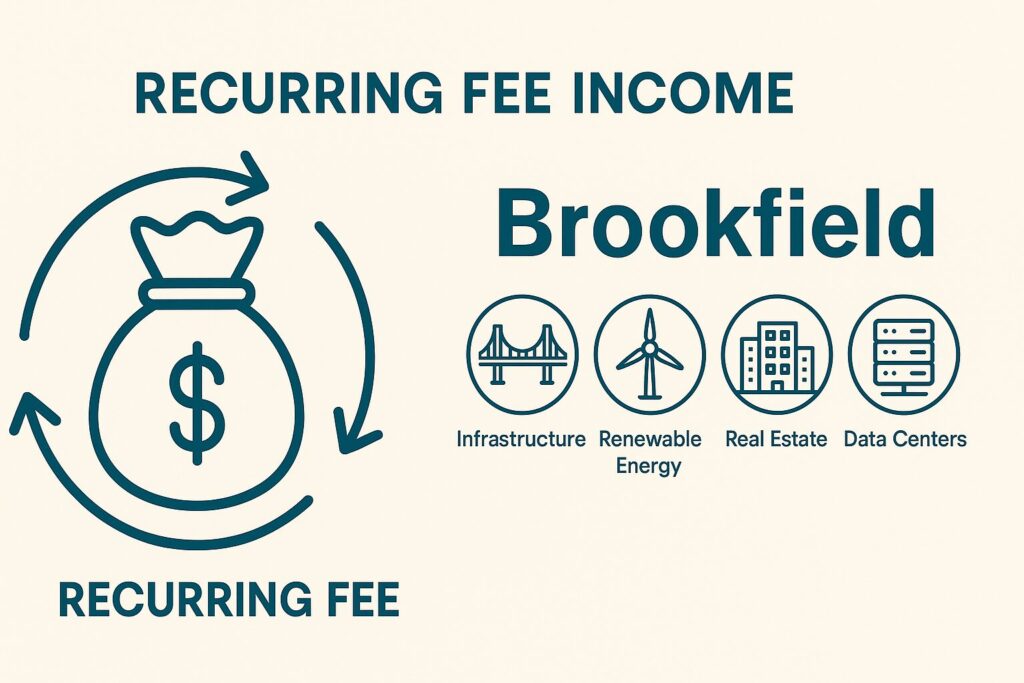
Predictable income from real assets, not risky bets.
Most companies you invest in make money by selling products or services. That’s fine—until sales drop, demand dries up, or market trends shift. But Brookfield Asset Management (BAM) does things differently—and that’s exactly what makes it so attractive for retirees who want stability.
BAM doesn’t rely on consumer sales or short-term trends. Instead, it gets paid by managing other people’s money—and collecting steady, recurring fees for doing so.
In this post, you’ll learn how Brookfield’s fee-based business model generates dependable profits, why that matters for dividend investors, and how it turns into a growing income stream you can rely on in retirement.
✅ Brookfield’s Business Model, Simplified
Brookfield is one of the largest alternative asset managers in the world. It oversees over $900 billion in assets across key sectors like:
- Infrastructure (toll roads, utilities)
- Renewable energy (wind, solar, hydro)
- Real estate (office buildings, logistics hubs)
- Private equity and credit
But here’s the important part: Brookfield doesn’t own all these assets outright.
Instead, institutional clients (like pension funds, endowments, and sovereign wealth funds) provide the capital, and Brookfield manages the investments for them.
For that service, Brookfield earns:
- Base management fees – A percentage of total assets under management (AUM), paid regularly
- Performance fees – A bonus when investments do especially well over time
These fees are contractual, recurring, and remarkably stable—even when markets get bumpy. Brookfield collects them like clockwork, and that predictable cash flow supports its growing dividend.
✅ Why Retirees Love This Model
Let’s face it: in retirement, you don’t want surprises. You want:
- Steady income
- Minimal volatility
- Inflation protection
- A business that thrives regardless of short-term trends
Brookfield delivers all of that by earning its income through long-term contracts, low overhead, and real-world assetsthat people rely on daily—like electricity grids, toll roads, and data centers.
As Brookfield’s assets under management grow, so do its fees—and so does its dividend to shareholders like you.
It’s a simple, scalable, and sustainable model that works beautifully for long-term income investors.
✅ Real-Life Example: Sarah’s Search for Safety
Sarah, a 72-year-old retired school administrator, wanted a stock that could give her steady income without the drama of market swings. After learning about BAM’s fee-based model, she bought shares in her IRA. Today, she receives a growing dividend every quarter—and says it’s one of the few investments that lets her “sleep through the news.”
✅ What Makes Brookfield Different
- No products to sell. BAM gets paid whether or not people are spending money.
- No dependence on interest rates or stock prices. It earns on real, physical assets.
- No guesswork. Revenues come from signed contracts—not wishful thinking.
This is the kind of company that retirees can feel good about owning for the long haul.
✅ The Bottom Line
Brookfield Asset Management makes money by managing real assets for long-term clients—and passing a portion of those earnings on to you through regular, growing dividends.
If you’re tired of guessing what the market will do next and want a stock you can count on, BAM’s business model may be the answer.
📘 This post is adapted from my book, The Single Best Dividend Stock for Retirees, available now at Amazon.com in both paperback and eBook formats.
In the book, you’ll discover how Brookfield works, how to invest in it safely, and how it can become the foundation of a worry-free income strategy in retirement.
Disclaimer
This content is for educational and informational purposes only and should not be considered financial, investment, or tax advice. Investing involves risk, including the possible loss of principal. Always conduct your own research or consult with a qualified financial advisor before making any investment decisions. The author is not a licensed financial advisor and does not provide personalized investment advice.